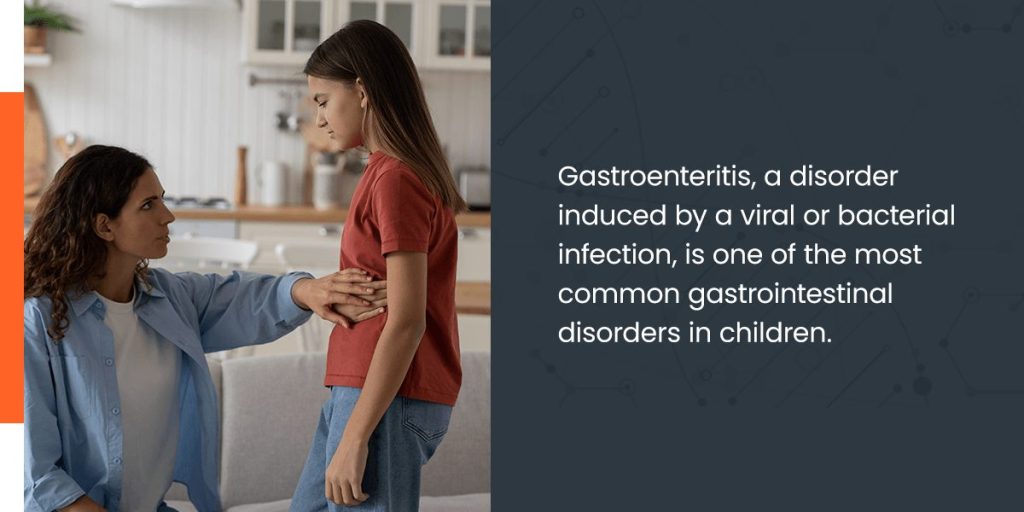These pathologies can present in varying degrees of severity, making accurate diagnosis imperative to guide suitable therapeutic interventions for children.
In this article, you can learn about the most common pediatric gastrointestinal disorders, their etiology, clinical presentation, and diagnostic methodologies for medical professionals. We also highlight the importance of proper diagnostic approaches to optimize children’s health outcomes.
Common Pediatric Gastrointestinal Disorders
The following are the most prevalent pediatric GI illnesses:
Gastroenteritis
Gastroenteritis, a disorder induced by a viral or bacterial infection, is one of the most common gastrointestinal disorders in children. Clinical manifestations of pediatric gastroenteritis include:
- Nausea
- Vomiting
- Diarrhea
- Abdominal pain
- Pyrexia
Dehydration may also ensue in children due to fluid loss through persistent vomiting and diarrhea.

The virus or bacteria responsible for gastroenteritis typically spreads through contaminated food or water or contact with an infected person. Children who attend daycare or school are at a higher risk of contracting the illness as a result of being in close proximity to other children.
Inflammatory Bowel Disease
Inflammatory bowel disease (IBD) is chronic, associated with ongoing inflammation of the digestive tract or parts of it. The disease can induce various clinical manifestations in children. Crohn’s disease and ulcerative colitis are the two main types of IBD. Clinical manifestations of IBD include the following:
- Abdominal pain
- Diarrhea
- Rectal bleeding
- Weight loss
- Fatigue
Some children can also experience joint pain, skin rashes, and eye inflammation.
While the medical community has yet to fully understand IBD’s exact etiology, they believe a combination of genetic, environmental, and immunological factors is at play. Children with a family history of IBD are at a higher risk of developing the disease. Consuming a diet high in fat and sugar, exposure to specific viruses or bacteria, and living in urban areas can also increase a person’s risk of developing IBD.
Irritable Bowel Syndrome
Irritable bowel syndrome (IBS) is another chronic condition affecting the digestive system. Common clinical manifestations of IBS in children include the following:
- Abdominal pain and distention
- Constipation
- Diarrhea
- Nausea
- Fatigue
- A sensation of incomplete bowel movements
While the exact etiology of pediatric IBS is unknown, researchers believe genetics, diet, and stress can contribute. Children with a family history of IBS or other digestive conditions have a higher risk of developing the syndrome.
Celiac Disease
Celiac disease is an autoimmune disorder characterized by an immune reaction to the protein gluten. When a child with this disease consumes gluten — found in wheat, barley, and rye — their immune system attacks the lining of their small intestine, which can cause damage and nutrient malabsorption.
Common clinical manifestations and secondary symptoms of pediatric celiac disease include:
- Diarrhea
- Abdominal pain
- Bloating
- Weight loss
- Fatigue
- Delayed growth and development
Celiac disease’s etiology has yet to be determined, though a combination of genetic and environmental factors might play a role. A family history of celiac disease or other autoimmune disorders can also contribute to children developing the disease.
Gastroesophageal Reflux Disease
Gastroesophageal reflux disease (GERD) occurs when gastric acid and contents flow back into the esophagus, leading to irritation and inflammation. Children with GERD typically complain of symptoms like:
- Heartburn — a burning sensation in the chest or throat.
- Regurgitation — a sour taste in the mouth.
- Dysphagia — difficulty swallowing foods or liquids.
A combination of factors, including a weak lower esophageal sphincter, a hiatal hernia, and certain medications might also contribute to GERD, though the exact etiology has yet to be determined.
Crohn’s Disease
Crohn’s disease, a type of IBD, can impact any segment of the digestive tract. While the exact etiology remains unidentified, healthcare professionals generally believe a combination of genetic, environmental, and immunological factors is at play.
Crohn’s disease can affect children of any age, and the clinical manifestations can vary depending on the location and severity of the digestive tract inflammation. Children with Crohn’s disease often experience:
- Persistent diarrhea
- Abdominal pain
- Weight loss
- Rectal bleeding
- Fever
- Fatigue
- Reduced appetite
In some cases, Crohn’s disease can lead to complications like malnutrition, growth delays, and abscesses or fistulas in the digestive tract.
What Causes GI Disorders in Children?
Several bacterial, viral, and parasitic pathogens have been implicated in pediatric GI disorders:
- Bacterial pathogens: Escherichia coli (E. coli) is a common pathogen that can cause diarrhea, abdominal cramps, and pyrexia and can be spread through contaminated food or water. Salmonella can cause similar symptoms and spread through contaminated food or water. Campylobacter is a third pathogen that can cause GI issues in children and is often spread through contaminated poultry products.
- Viral pathogens: Rotavirus is a common culprit in pediatric GI disorders. Rotavirus infections can cause diarrhea, emesis, and pyrexia and are spread through contact with contaminated surfaces or objects. Norovirus can also cause GI illness and is transmitted through contaminated water or food or contact with infected individuals.
- Parasitic pathogens: Parasitic pathogens like Giardia can also lead to gastrointestinal illnesses in children. Giardia is spread through contaminated food or water or contact with an infected person. Infections can result in diarrhea, abdominal cramps, and nausea. Cryptosporidium causes similar manifestations and is spread in the same ways.
Challenges of Diagnosing GI Diseases in Children With Traditional Testing
Traditional stool testing methods present several challenges in diagnosing pediatric GI disorders. One of the major challenges is sample collection due to difficulties in obtaining adequate stool samples from children — a child’s fear or discomfort may cause the sample to be compromised, and thus produce inaccurate test results.
Additionally, traditional testing methods may lack the sensitivity to detect certain rare pediatric gastrointestinal problems. These hurdles may necessitate specialized tests like PCR testing. Some chronic conditions may also warrant more comprehensive diagnostic procedures such as endoscopy or colonoscopy.
While traditional stool testing can be a valuable tool for diagnosing pediatric GI diseases, it’s important to recognize the limitations and consider other testing methods when necessary.
The Importance of Diagnosing Pediatric Gastrointestinal Problems
Identifying the root cause of a GI disorder can help healthcare providers determine the most effective treatment approach, which can significantly improve a child’s quality of life.
A misidentified GI disorder can lead to misdiagnosis and potentially exacerbate the child’s condition. Some GI disorders can have serious complications if left untreated or improperly managed. For instance, IBD can lead to severe inflammation and damage to the digestive tract, which can result in malnutrition, growth problems, and even life-threatening complications.
Moreover, some GI illnesses may have underlying genetic causes that require specialized treatment and management. For example, children with cystic fibrosis may require enzyme replacement therapy, nutritional supplementation, and other specialized treatments to manage their GI manifestations.
Identify Gastrointestinal Pathogens in Children With Applied BioCode
Applied Biocode’s GI pathogen panel is a powerful tool for identifying pediatric gastrointestinal disorders. The panel detects a wide range of pathogens that can cause GI manifestations, including bacteria, viruses, and parasites. It uses multiplex PCR technology to distinguish multiple pathogens in a single test, helping healthcare professionals pinpoint the underlying cause of a child’s GI concerns more quickly and accurately.
Incorporate our GI pathogen panel into your pediatric GI testing practice for accurate and timely diagnoses. Contact Applied Biocode today for more information!



